October 1959
The following events occurred in October 1959:
| << | October 1959 | >> | ||||
|---|---|---|---|---|---|---|
| Su | Mo | Tu | We | Th | Fr | Sa |
| 1 | 2 | 3 | ||||
| 4 | 5 | 6 | 7 | 8 | 9 | 10 |
| 11 | 12 | 13 | 14 | 15 | 16 | 17 |
| 18 | 19 | 20 | 21 | 22 | 23 | 24 |
| 25 | 26 | 27 | 28 | 29 | 30 | 31 |

October 5, 1959: IBM 1401, the first business computer, is introduced

October 26, 1959: Earth's people see the other side of the Moon for the first time

October 25, 1959: The last propeller driven Air Force One flight ends
October 1, 1959 (Thursday)
- Aleksandr Alekseyev, a Soviet KGB agent and correspondent for TASS, arrived in Cuba to forge a relationship between the U.S.S.R. and the Castro government. By October 12, he had met with Che Guevara, and by October 15 with Fidel Castro, creating a Soviet ally 90 miles (140 km) from the United States.[1]
- NASA Headquarters approved funds for the following major changes to the Mercury spacecraft: egress hatch installation, astronaut observation window installation, rate stabilization and control system, main instrument and panel redesign, installation of reefed ringsail landing parachute, and non-specification configurations of spacecraft. With reference to the last item, the original contract with McDonnell had specified only one spacecraft configuration, but the various research and development flight tests required changes in the configuration.[2]
- NFL Enterprises, the forerunner to NFL Properties, was created as a joint project between Western star Roy Rogers and the owners of the 12 NFL teams. The first licensed product was glassware, to be given away at Standard Oil filling stations.[3]
- Born: Brian P. Cleary, American children's author, in Lakewood, Ohio; Youssou N'Dour, Senegalese singer, in Dakar
October 2, 1959 (Friday)
- The political system of Panchayati Raj was revived in India, starting with legislation in the State of Rajasthan to allow villages to elect their own local council (Gram Panchayat) to have authority on selected issues. The first new councils were in villages in the Nagaur district.[4]
- A total eclipse of the sun was visible from the northeast United States to West Africa. During the brief time in which the Moon came between the Sun and the Earth, Maurice Allais confirmed the "Allais effect", causing a change in the swing of a pendulum, which he had first observed during a 1954 total eclipse.[5] The point of greatest eclipse was in the Sahara Desert in Mali.
- General Motors introduced the Chevrolet Corvair automobile. The Corvair, subject of Ralph Nader's 1965 book Unsafe at Any Speed, was manufactured until the 1969 model.[6]
- Specifications for the Mercury pressure suit were issued. The suit procurement program was divided into two phases: Phase I, operational research suits which could be used for astronaut training, system evaluation, and further suit development; and Phase II, Mercury pressure suits in the final configuration.[2]
- The Twilight Zone debuted on CBS television with the episode "Where Is Everybody?"[7]
October 3, 1959 (Saturday)

October 3, 1959: Theodore Roosevelt's daughter at the submarine christening
- The ballistic missile submarine, USS Theodore Roosevelt, was launched from Mare Island. Alice Roosevelt Longworth, the 75-year-old daughter of the 26th American president, broke the champagne across the submarine hull on her second attempt.[8]
- Born:
- Fred Couples, American professional golfer (1992 Masters), in Seattle
- Greg Proops, American comedian, in Phoenix
- Jack Wagner, American actor (General Hospital) in Washington, Missouri
October 4, 1959 (Sunday)
- Lunik 3, billed by the Soviet Union as "the first automatic space station", was launched into space. It would orbit the Moon and show a side never before seen by humanity.[9]
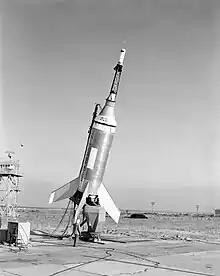
October 4, 1959: Little Joe rocket
- A Little Joe launch vehicle carrying a boilerplate Mercury spacecraft was successfully launched from Wallops Island. The flight, lasting 5 minutes 10 seconds, gained a peak altitude of 37.12 statute miles, and a range of 79.4 statute miles. The destruct packages carried on board the Little Joe launch vehicles were successfully initiated well after the flight had reached its apex. There was a slight malfunction in the Little Joe launch vehicle when ignition of the two second-stage Pollux motors fired before the exact time planned. The planned trajectory was little affected and the structural test of the vehicle, greater than planned, was benefited.[2]
- Born: Chris Lowe, British musician (Pet Shop Boys), in Blackpool, Lancashire
October 5, 1959 (Monday)
- The IBM 1401 computer and data processing system was introduced, providing the first fully transistorized computer intended for business use.[10] The three-piece system, which could be rented for $2,500 a month, had a memory ranging from 1.4 KB to 16K, could read 800 punchcards per minute and could print 600 lines per minute. More than 14,000 units were installed.[11]
- The Mead Johnson food company introduced two powdered nutrition products, both of which became popular, on the same day. Enfamil, which remains an active brand 60 years later, was the first infant formula designed to be "a low protein duplication of mother's milk", while Metrecal was a low-calorie diet food, to be mixed with water for form a milk shake like product and "containing the essential nutrients of protein, carbohydrate, fat, vitamins and minerals" to be consumed four times a day for 900 calories of nutrition.[12]
- Born:
- Maya Lin, American architect best known for Vietnam Memorial, in Athens, Ohio
- Kelly Joe Phelps, blues musician, in Sumner, Washington (d. 2022)
October 6, 1959 (Tuesday)
- At a congressional subcommittee hearing investigating allegations of fraud on television quiz programs, former game show contestants Herbert Stempel and James Snodgrass revealed that they had been supplied the answers in advance on the show Twenty-One.[13] The two would be portrayed in the film Quiz Show by John Turturro and Douglas McGrath, respectively, in 1994.
- Cambodia filed suit against Thailand in the World Court claiming a violation of its territory by Thai use of the Temple of Preah Vihear. In 1962, the Court ruled in favor of Cambodia.[14]
- The International Olive Oil Council was created, with 17 member nations, representing 97% of the world's exports of olive oil.[15]
- A record 92,706 fans watched Game 5 of the World Series between the Dodgers and the White Sox.
October 7, 1959 (Wednesday)
- From 0330 to 0410 GMT, the Lunik 3 probe took the first pictures of the far side of the Moon, 29 images that were later transmitted back to Earth.[9]
- A Taiwanese RB-57 surveillance plane, flying at an altitude of 20,000 metres (66,000 ft), was downed by three V-750 missiles as it flew near Beijing. It was the first time that a surface-to-air missile (SAM) had brought down an aircraft.[16]
- On Baghdad's al-Rashid Street, Iraq's President Abd al-Karim Qasim was ambushed on his way to the East German embassy. The five-man team, led by future Iraqi President Saddam Hussein, killed Qasim's driver and wounded Qasim. One assassin died and Saddam himself was injured, but escaped to a farm.[17] After the U.S. invasion of Iraq in 2003, Saddam fled to the same farm, where he was captured on December 13 of that year.[18]
- The U.S. Court of Claims ruled that the Tlingit and Haida Indian tribes had been the original owners of southeast Alaska and entitled to monetary compensation. An award for $7.5 million was made in 1968.[19]
- Born:
- Simon Cowell, English television producer and judge (American Idol and Britain's Got Talent), in Brighton, East Sussex
- Lourdes Flores, Peruvian presidential candidate 2001 and 2006; in Lima
- Michael Paré, American film actor (The Philadelphia Experiment), in Brooklyn
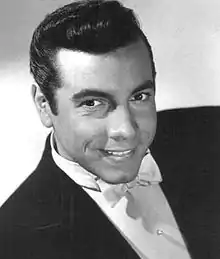
Mario Lanza
- Died: Mario Lanza, 38, American tenor, died of a pulmonary embolism
October 8, 1959 (Thursday)
- In the British general election, the Conservatives (led by Prime Minister Harold Macmillan) increased their majority in Parliament, capturing 365 of the 630 seats. Labour had 258 seats, followed by the Liberals (6) and the Independent Conservative Party (1).[20]
- The Los Angeles Dodgers beat the Chicago White Sox 9–3 to win the 1959 World Series in the sixth game. Larry Sherry, the winning pitcher, had saved Games 2, 3 and 4 as well.[21]
- The Central Committee of the Communist Party of the Soviet Union issued "About some changes in History lessons in school", a decree revising the curriculum and textbooks in Soviet schools, with an emphasis on "the inevitability of the collapse of capitalism and the triumph of communism."[22]
October 9, 1959 (Friday)
- Russell Langelle, a CIA agent with a cover as security officer at the Embassy of the United States in Moscow, was arrested as he stepped off a city bus, where he had met Soviet double-agent Pyotr Popov. Langelle was expelled from the Soviet Union, and Popov was later executed for treason.[23]

Bullard
- Eugene Bullard, who had been the first African-American military pilot, received the Croix de la Légion d'honneur, France's highest military award, at a ceremony in Paris, for his services to the French Foreign Legion during World War I.[24]
- Died: Shiro Ishii, 67, Japanese germ warfare specialist who was granted immunity from war crimes prosecution
October 10, 1959 (Saturday)
- Fatah, Palestinian nationalist political party, was founded by Yasser Arafat, Khalil al-Wazir, and others to fight for Palestinian independence. "Fatah" is a reverse acronym for Harakat al Tahir al Filastini.[25]
- A courageous letter of protest from author Viktor Nekrasov appeared in the Soviet weekly Literaturnaya Gazeta, after Nekrasov learned that the city planners of Kiev planned to pave over Babi Yar, site of the 1941 Nazi massacre of more than 30,000 Ukrainians, mostly Jews. Learning that a soccer stadium was to be built there, Nekrasov wrote, "How is this possible? Who could have thought of such a thing? On the site of such a colossal tragedy to make merry and play football? No! This must not be allowed!" [26] Yevgeny Yevtushenko and Anatoly Kuznetsov were inspired by Nekrasov's protest to write their own works about Babi Yar.[27]

Watts Towers
- The Watts Towers, a metal sculpture by Simon Rodia, withstood a "10,000 pound pull" stress test and earned its right to remain a Los Angeles landmark. The city's Building and Safety Department had ordered the demolition of the landmark, but agreed to let Rodia prove that the 99-foot-tall (30 m) structure would not collapse.[28]
- James Earl Ray was arrested after robbing a supermarket in St. Louis, and given a 20-year sentence in the Missouri State Penitentiary. With more than twelve years remaining on his jail term, Ray would escape on April 23, 1967, and would carry out the assassination of Martin Luther King Jr. the following year.[29]
- Born: Kirsty MacColl, British singer and songwriter, in Croydon (killed in boating accident, 2000)
October 11, 1959 (Sunday)
- The Malagasy Republic on the island of Madagascar held elections for the leaders of 739 rural communes, scheduled to take office on January 1. "The great majority of rural voters," a historian would later note, "had no idea what the new communes were for, and most of the officers elected not only were illiterate but lacked a sense of civic responsibility."[30]
- War broke out in the Belgian Congo between two rival tribes, the Lulua and the Baluba, in the city of Luluabourg (now Kananga).[31] Fighting would continue throughout the first campaigns for the first elected legislature in May 1960, in advance of the Congo's independence from Belgium.[32]
- Died:
- Bert Bell, 64, the Commissioner of the National Football League, died of a heart attack while attending the Eagles-Steelers game in Philadelphia. Bell, who had been Commissioner since 1946, had owned both teams earlier in his career. Sports columnist Red Smith later wrote, "It was like Caruso dying in the third act of Pagliacci".[lower-alpha 1][33]
- Rex Griffin, 53, American country singer
- Nop Bophann, the editor of Pracheachon, a leftist newsweekly in Cambodia, died of his wounds two days after he was shot by the kingdom's security police while leaving his office. One author would comment later, "His death was probably intended as a gesture of reassurance to the Right that, notwithstanding Cambodia's difficulties with America, the communists would be held in check."[34]
October 12, 1959 (Monday)
- The first successful test of an anti-satellite weapon took place as a missile, fired from a B-47 bomber, passed within 4 miles (6.4 km) of the orbiting satellite Explorer 4, close enough to have destroyed it with a one-megaton nuclear explosion.[35]
- Yuri Gagarin and Georgi Shonin were among the first test pilots selected to be Soviet cosmonauts, following evaluations at the air base at Murmansk. Gagarin would become, on April 12, 1961, the first man in outer space aboard Vostok 1.[36]
- Died: Arnolt Bronnen, 64, Austrian playwright and film director
October 13, 1959 (Tuesday)
- The satellite Explorer 7 was launched, carrying a radiometer invented by Verner E. Suomi, and other devices that permitted the first measurements from space of Earth's radiation and the first climatological studies. This satellite also successfully demonstrated a method of controlling internal temperatures.[2][37]
- Born: Marie Osmond, American pop singer (Paper Roses), in Ogden, Utah
October 14, 1959 (Wednesday)
- Ruth Urdanivia, a widow in Allentown, Pennsylvania, murdered her five children with overdoses of barbiturates, and unsuccessfully attempted suicide. After being found sane to stand trial, she pleaded guilty and was sentenced to life in prison. She was paroled in 1967.[38]
.JPG.webp)
Errol Flynn as Robin Hood, with Olivia de Havilland
- Died:
- Errol Flynn, 50, Australian-born film actor who popularized the "swashbuckler" action film genre, died of a heart attack[39]
- Alphonso Trent, 54, American jazz pianist
October 15, 1959 (Thursday)
- KGB agent Bogdan Stashinsky murdered Ukrainian nationalist Stepan Bandera in Munich, West Germany. The weapon was a gun that fired hydrogen cyanide gas into Bandera's face. Stashinsky, who had killed newspaperman Lev Rebet in the same manner in 1957, swallowed an antidote and escaped.[40]
- The Antarctic Conference opened in Washington with representatives of 12 nations in attendance. The Antarctic Treaty was signed on December 1 and became effective in 1961.[41]
- Space Task Group personnel held a meeting at Langley Research Center with representatives from the Lewis Research Center to clarify Project Mercury research support needs at Lewis.[2]
- A B-52F Stratofortress bomber, carrying two nuclear weapons, collided with a KC-135 refueling tanker, causing both planes to explode in mid-air[42] and killing seven of the 12 people on the two airplanes, though four members of the bomber crew were able to parachute to safety.[43] The collision happened over Breckinridge County, Kentucky in the U.S., with the bomber (and its nuclear weapons) crashing on a farm near the community of Glen Dean and the tanker hitting a hillside near McQuady.[44] The two nuclear weapons on the bomber were recovered without release of radiation.[45]
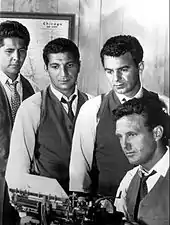
The cast of The Untouchables, with Stack on far right
- The television series The Untouchables, based on the autobiography of federal Prohibition enforcement agent Eliot Ness, premiered on ABC as one of the most violent shows ever to be shown on television, with killings of Chicago gangsters shown on every episode.[46] Starring Robert Stack as Ness, the show would run for four seasons and 118 episodes and was popular in spite of (or perhaps because of) its violent nature.
- Born:
- Sarah Ferguson, English publishing firm employee who was married to Britain's Prince Andrew from 1986 to 1996 and was popularly known as "Fergie". After the divorce, she was no longer a member of British royalty but retained nobility as the Duchess of York.
- Emeril Lagasse, American chef and TV celebrity known generally as "Emeril"; in Fall River, Massachusetts
- Died:
- Phetsarath Rattanavongsa, 69, former Prime Minister of Laos who served for six months as the head of state after King Sisavang Vong was temporarily removed from office
- Elliott White Springs, 63, American World War I ace credited with shooting down 16 enemy aircraft
October 16, 1959 (Friday)
- Lee Harvey Oswald arrived in Moscow on a six-day visa, and applied for Soviet citizenship. Coincidentally, he would begin work at the Texas School Book Depository four years to the day later, on October 16, 1963.[47]
- Television was inaugurated in the State of Western Australia as TVW7 went on the air.[48]

Marshall
- Died: George C. Marshall, 78, World War II general, United States Secretary of State 1947–1949, and 1953 Nobel Peace Prize laureate in recognition of the Marshall Plan for aid to Western Europe during the Cold War
October 17, 1959 (Saturday)
- Belgian authorities in colonial Rwanda removed three Tutsi chiefs, Kayihura, Rwangombwa, and Mungalurire, for inciting their tribesmen to violence against the Hutu tribe.[49]
- After 26 years and 9,477 performances at the Theatre Mart in Los Angeles, the William H. Smith temperance play The Drunkard closed.[50]
- Born:
- Francisco Flores Pérez, President of El Salvador 1999–2004, in Santa Ana (d. 2016)
- Norm MacDonald, Canadian actor and comedian, in Quebec City (d. 2021)
- Richard Roeper, American film critic for the Chicago Sun-Times and successor to the late Gene Siskel as co-host (with Roger Ebert), of At the Movies; in Chicago
- Ron Drummond, American music historian, in Seattle
October 18, 1959 (Sunday)
- The X-3C, a circular wing hovercraft designed at Princeton University, made its first flight. 20 feet (6.1 m) in diameter and constructed of aluminum, the X-3C has been described as the closest approximation to a flying saucer.[51]
- Former President Harry S. Truman appeared in a series of comic sketches on The Jack Benny Program. Critics disagreed on whether the dignity of the American presidency had been compromised.[52]
- Died: Boughera El Ouafi, 61, Algerian runner and 1928 Olympic marathon winner, was shot to death while dining in a cafe[53]
October 19, 1959 (Monday)
- The Miracle Worker, starring Anne Bancroft as Annie Sullivan and Patty Duke as Helen Keller, opened on Broadway at the (now closed) Playhouse Theatre. The production won a Tony Award for the best play, best dramatic actress (for Bancroft), and best director (Arthur Penn).[54]
October 20, 1959 (Tuesday)
- The University of Oxford revised its rules to elevate its five affiliated women's colleges (Lady Margaret Hall or LMH, Somerville, St Anne's, St Hugh's and St Hilda's) to equal status with its men's colleges.[55]
- Died: Werner Krauss, 75, German film actor
October 21, 1959 (Wednesday)
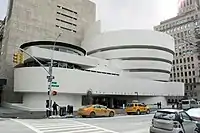
The Guggenheim
- The Solomon R. Guggenheim Museum, popularly referred to as "the Guggenheim", opened in New York. The art museum, designed by Frank Lloyd Wright, is built in the form of a spiral.[56]
- After being told to leave the U.S.S.R., Lee Harvey Oswald slashed his wrists at his Moscow hotel room. His life was saved after Rima Shirokova found Oswald unconscious and had him taken to the Botkinskaya Hospital.[57]
- Major Pedro Díaz Lanz, who had been chief of the Cuban Air Force until defecting in July, flew an airplane from Florida and dropped thousands of leaflets over Havana, then returned to the U.S. In the chaos that followed, two people died and 45 were injured, and Fidel Castro charged that the United States had bombed Cuba.[58]
- Wernher von Braun's team of rocket scientists was transferred from the Army Ballistic Missile Agency to NASA.[59]
- Ten members of India's Central Reserve Police Force (CRPF) were killed at the Kongka Pass near Ladakh at Hot Springs, while defending against an incursion by soldiers from the neighboring People's Republic of China. The other members of the 21-man patrol were taken prisoner, though later released. October 21 is now observed as Police Commemoration Day throughout India.[60]
- Born:
- Ken Watanabe, Japanese film actor known for The Last Samurai; in Koide
- Tony Ganios, American film actor known for Porky's; in Brooklyn
October 22, 1959 (Thursday)
- Rioting broke out in San'ya, the ghetto area of Tokyo, as a crowd of about 300 attacked the local police station.[61]
- The Franco-German Extradition Treaty, adopted in 1951, went into effect.[62]
- VES (vesicular exanthema of swine), which had caused a 15-month-long epizootic in 1952 and 1953, was declared to be eradicated.[63]
- Died: Joseph Cahill, 68, Premier of New South Wales since 1952, died of a heart attack.
October 23, 1959 (Friday)
- India and Pakistan signed an agreement that provided that any border disputes would be submitted to "an impartial tribunal consisting of three members".[64]
- The Mummy, the most popular horror film to that time, was released in American theaters.[65]
- Born: "Weird Al" Yankovic, American singer and parodist; in Lynwood, California
- Died: William Golden, American graphic designer, designed of the CBS logo (b. 1911)[66]
October 24, 1959 (Saturday)
- Cuba instituted Law 851, nationalizing more than 150 American investments, including the hotels, casinos and racetrack. Foreign tourism, which had been nearly 275,000 in 1957, fell to 87,000 by 1960.[67]
- Playboy's Penthouse began a brief run on syndicated television. Broadcast live from Chicago, the program was in the format of a cocktail party hosted by Hugh Hefner. Besides increasing sales of the magazine, the program paved the way to the creation of the Playboy Clubs.[68]
October 25, 1959 (Sunday)
- A propeller driven plane served as Air Force One for the last time. President Eisenhower flew from Augusta, Georgia, back to Washington on the "Columbine", a VC-121E Super Constellation.[69]
- The shrine "Our Lady of the Highways" was dedicated on Route 66 in Litchfield, Illinois, for travelers who wished to seek the assistance of the Virgin Mary on their journeys.[70]
- Born: Christina Amphlett, Australian singer for the Divinyls; in Geelong, Victoria (died 2013 from breast cancer)
October 26, 1959 (Monday)
- Earth's residents were able to see the far side of the Moon for the first time, as photographs from the Lunik 3 satellite were released by the Soviet Union.[71]
- The Plymouth Valiant was unveiled by Chrysler, not in Detroit but at the International Motor Show in London.[72]
- Born: Evo Morales, President of Bolivia 2006 to 2019, and the first Bolivian president who was of an indigenous ethnic group, the Aymara people; in Orinoca
October 27, 1959 (Tuesday)
- More than 1,000 people in Mexico were killed by a hurricane that struck the states of Colima and Jalisco. The town of Minatitlán was heaviest hit, with winds, floods and landslides.[73]
- Pakistan's President Muhammad Ayub Khan instituted the program he called "Basic Democracy", whereby the nation would be divided into 80,000 constituencies, each of which would elect its own representative. These 80,000 persons would elect members of parliament and provincial legislatures, as well as the President, and would carry out governmental programs.[74]
- Born: Rick Carlisle, American NBA player, later coach of the NBA 2010-11 champion Dallas Mavericks; in Ogdensburg, New York
October 28, 1959 (Wednesday)
- The synthetic fabric spandex (trademarked as Lycra) was introduced by DuPont, relying upon a "Fiber K", a synthetic elastomer that was lighter and more durable than conventional elastic, making it ideal for swimsuits.[75]
- U.S. Senator John F. Kennedy of Massachusetts began planning for a presidential run with a meeting at Bobby Kennedy's home in Hyannisport.[76]
October 29, 1959 (Thursday)
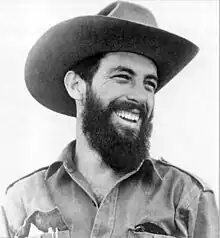
Cienfuegos
- Camilo Cienfuegos, the 26-year-old Commander of Cuba's revolutionary army, took off in a Cessna 310 from Camagüey, bound for Havana, along with three other people. The airplane vanished without a trace, although a bulletin on November 4 from Cuba announced that Cienfuegos had been found on "an island off southern Cuba".[77] Cienfuegos was later celebrated as a Cuban martyr.[78]
- The character of Astérix the Gaul made his debut, appearing in the first regular issue of the comic magazine Pilote.[79]
- The Arkansas State Press, an African-American weekly newspaper founded in 1941 by Lucious Bates, published its last issue. During its 14 years, the newspaper had lobbied to end racial discrimination in Arkansas.[80]
- Died: Sisavang Vong, 74, King of Laos, since independence and King of Luang Prabang during the French colonial period since 1904, died in Luang Phrabang. He was succeeded by Crown Prince Savang Vatthana, who would be the last monarch.[81]
October 30, 1959 (Friday)
- In Stanleyville (now Kisangani), thirty African protesters were killed when colonial soldiers in the Belgian Congo dispersed a protest march made by Patrice Lumumba's Congolese National Movement, and Lumumba was arrested.[82]
- The Alabama Polytechnic Institute was formally renamed as Auburn University.[83]
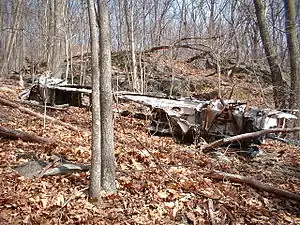
Flight 349 wreckage in 2002
- Piedmont Airlines Flight 349, en route from Washington, D.C., crashed into a mountain near Crozet, Virginia, near the plane's destination of Charlottesville, killing 23 of the 24 people on board. The sole survivor, Phil Bradley, was located after 36 hours, and would participate in the dedication of a memorial on the 50th anniversary of the disaster.[84][85]
- Died: War Admiral, 25, American thoroughbred horse who won the Triple Crown of U.S. horse racing in 1937
October 31, 1959 (Saturday)
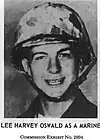
Lee Oswald USMC
- Lee Harvey Oswald entered the U.S. Embassy in Moscow and told officer Richard Edward Snyder that he wished to renounce his American citizenship. Snyder accepted Oswald's passport and a written note but told Oswald that further paperwork would need to be completed. Oswald did not complete the process and returned to the United States in 1962.[86] News of the defection made the front pages of American newspapers four years before he would resurface as the accused assassin of John F. Kennedy.[87]
- Television was seen in Africa for the first time, as the Western Nigeria Television Service started commercial broadcasting on WNTV in Ibadan.[88]
- The 576th Flight Test Squadron armed an Atlas D missile at Vandenberg Air Force Base, creating the first American ICBM to carry a nuclear warhead. The missile was then placed on alert.[89]
- Born: Neal Stephenson, American sci-fi author known for The Diamond Age; in Fort Meade, Maryland
Notes
- Pagliacci in fact has only two acts.
References
- Khrushchev, Sergei N. (2001). Nikita Khrushchev and the Creation of a Superpower. Translated by Benson, Shirley. Pennsylvania State University Press. p. 491.
-
 This article incorporates text from this source, which is in the public domain. Grimwood, James M. "PART II (A) Research and Development Phase of Project Mercury October 3, 1958 through December 1959". Project Mercury - A Chronology. NASA Special Publication-4001. NASA. Retrieved 5 February 2023.
This article incorporates text from this source, which is in the public domain. Grimwood, James M. "PART II (A) Research and Development Phase of Project Mercury October 3, 1958 through December 1959". Project Mercury - A Chronology. NASA Special Publication-4001. NASA. Retrieved 5 February 2023. - Oriard, Michael (2007). Brand NFL: Making and Selling America's Favorite Sport. University of North Carolina Press. p. 3.
- Arora, Ramesh K.; Goyal, Rajni (1995). Indian Public Administration: Institutions and Issues. Wishwa Prakashan. p. 287.
- Allais, Maurice (1993). "The Passion for Research". Eminent Economists: Their Life Philosophies. Cambridge University Press. pp. 39–41.
- Gerber, Jurg; Jensen, Eric L (2007). Encyclopedia of White-collar Crime. Greenwood Press. pp. 46–47.
- Booker, M. Keith (2004). Science Fiction Television: A History. Praeger. pp. 8–9.
- "Big Stick A-Sub Goes Down Ways". Oakland Tribune. October 4, 1959. p. 1.
- Ulivi, Paolo; Harland, David M. (2004). Lunar Exploration: Human Pioneers and Robotic Surveyors. Springer-Verlag. pp. 26–28.
- IBM Archives.
- Reilly, Edwin D. (2003). Milestones in computer science and information technology. Greenwood Press. pp. 129–130.
- "Mead Introduces 2 New Items". The Evansville Press. Evansville, Indiana. October 1, 1959. p. 8-A – via Newspapers.com.
Two new Mead Johnson and Company products will go on the market Monday — one of them a 'painless' weight control product, the other a low protein duplication of mother's milk.
- J. Hoberman, The Magic Hour: Film at Fin de Siècle (Temple University Press, 2003), pp152–153; "2 Witnesses Bare TV Quiz Show Fix", Oakland Tribune, October 6, 1959, p1
- Shabtai Rosenne and Terry D Gill, The World Court: What It Is and How It Works (Kluwer Academic Publishers, 1989), pp190–191
- Amos J. Peaslee, International Governmental Organizations, Pt. 2: Agriculture, Commodities, Fisheries, Food, and Plants (Nijhoff, 1975) pp321–322
- Zaloga, Steve (2007). Red SAM: The SA-2 Guideline Anti-Aircraft Missile. New Vanguard Press. p. 8.
- Cockburn, Andrew; Cockburn, Patrick (2002). Saddam Hussein: An American Obsession. Verso. p. 72.
- "FBI notes: Saddam Hussein sought familiar refuge". Associated Press. July 2, 2009.
- Daley, Patrick; James, Beverly A (2004). Cultural Politics and the Mass Media: Alaska Native Voices. University of Illinois Press. p. 81.
- Frank Conley, General Elections Today (St. Martin's Press, 1994), pp27–31
- "Seven Greatest World Series Relief Appearances", by George Vass, Baseball Digest (October 1995), pp21–22
- Arkady B. Tsfasman, from Totalitarian and Authoritarian Regimes in Europe: Legacies and Lessons from the Twentieth Century (Berghahn Books, 2006), p559
- Tennent H. Bagley, Spy Wars: Moles, Mysteries, and Deadly Games (Yale University Press, 2007), pp74–75
- Betty Kaplan Gubert, Miriam Sawyer and Caroline M. Fannin, Distinguished African Americans in Aviation and Space Science (Oryx Press, 2002), pp55–60
- Kameel B. Nasr, Arab and Israeli Terrorism: The Causes and Effects of Political Violence, 1936–1993 (McFarland & Co., 1997), pp40–41
- p65
- William Korey, in The Holocaust in the Soviet Union: Studies and Sources on the Destruction of the Jews in the Nazi-occupied Territories of the USSR, 1941–1945 (M.E. Sharpe, 1993), p45
- Sarah Schrank, Art and the City: Civic Imagination and Cultural Authority in Los Angeles (University of Pennsylvania Press, 2009), p145
- "Ray, James Earl", The Scribner Encyclopedia of American Lives, Vol. V, pp469–471
- Thompson, Virginia; Adloff, Richard (1965). The Malagasy Republic: Madagascar Today. Stanford University Press. p. 151.
- Kisangani, Emizet Francois (2016). "Association des Lulua-Freres". Historical Dictionary of the Democratic Republic of the Congo. Rowman & Littlefield. p. 79.
- Nzongola-Ntalaja, Georges (2002). The Congo: From Leopold to Kabila: A People's History. Zed Books. p. 104.
- Yost, Mark (2006). Tailgating, Sacks, and Salary Caps: How the NFL Became the Most Successful Sports League in History. Kaplan Publishing. pp. 63–64.
- Short, Philip (2004). Pol Pot: Anatomy of a Nightmare. Henry Holt and Company. p. 130.
- Bulkeley, Rip; Spinardi, Graham (1986). Space Weapons: Deterrence or Delusion?. Barnes & Noble Books. p. 17.
- Burgess, Colin; Hall, Rex (2009). The First Soviet Cosmonaut Team: Their Lives, Legacy, and Historical Impact. Springer. pp. 18–19.
- Williamson, Mark (2006). Spacecraft Technology: The Early Years. Institution of Electrical Engineers. pp. 132–133.
- Flowers, R. Barri; Flowers, H. Loraine (2004). Murders in the United States: Crimes, Killers and Victims of the Twentieth Century. Jefferson, North Carolina: McFarland & Co. p. 138. ISBN 978-0786420759.
- "Errol Flynn Dies: Veteran Hollywood Swashbuckler, 50, Succumbs in Canada". Los Angeles Times. October 15, 1959. p. I-1.
- Trento, Joseph J. (2005). The Secret History of the CIA. Carroll & Graf. p. 180.
- Fogg, G. E. (1992). A History of Antarctic Science. Cambridge University Press. p. 177.
- "Crash in Air Sighted Over Four States— Jet Bomber Held Atom Weapon". Chicago Daily Tribune. October 16, 1959. p. 1.
- "A-Armed B52, Tanker Crash In Flames Near Hardinsburg". Lexington Leader. Lexington, Kentucky. October 16, 1959. p. 1.
- Levy, Alan (October 16, 1959). "Air Force Probing Mid-Air Jet Collision— 2 Black Gashes Mark Graves of 8 Fliers; Unexploded A-Bomb Cargo Under Wraps". Courier Journal. Louisville, Kentucky. p. 1.
- Lake, Jon (2004). B-52 Stratofortress Units in Combat, 1955–1973. Oxford Osprey. p. 18.
- Edgerton, Gary R. (2007). The Columbia History of American Television. Columbia University Press. p. 196.
- The Warren Commission Report, p12, p15
- Farewell Cinderella: Creating Arts and Identity in Western Australia (University of Western Australia Press, 2003), p232
- Ian Linden, Church and Revolution in Rwanda (Manchester University Press, 1977), p267
- The Cambridge Guide to American Theatre, 2d. Ed. (Cambridge University Press, 2007), p403
- Cramp, Leonard G. (1996). UFOs and Anti-gravity: Piece For a Jig-saw. Adventures Unlimited Press. pp. 43–44.
- Schroeder, Alan (2004). Celebrity-in-chief: How Show Business Took Over the White House. Westview Press. p. 61.
- "Bouguera El Ouafi". Olympedia. OlyMADMen. Retrieved 3 April 2023.
- The Miracle Worker, Patty Duke fan site
- "A Woman's Place". Oxford Today.
- John H. Davis, The Guggenheims: An American Epic (S.P.I. Books, 1989), pp198–200
- The Warren Commission Report, pp 691–692
- Alan L. McPherson, Yankee No!: Anti-Americanism in U.S.-Latin American Relations (Harvard University Press, 2003), pp59–61
- David J. Darling, The Complete Book of Spaceflight: From Apollo 1 to Zero Gravity (Wiley, 2003), p363
- N.R. Madhava Menon, ed., Criminal Justice: India Series (Allied Publishers, 2002), Vol. 8, pp182–183
- Joe Moore, The Other Japan: Conflict, Compromise, and Resistance Since 1945 (M.E. Sharpe, 1997), pp91–92
- Israel Yearbook on Human Rights 1977, (Martinus Nijhoff, 1977), pp67–68
- George W. Beran, ed., Handbook of Zoonoses, 2d. Ed., Section B, p445
- Reports of Judgments, Advisory Opinions and Orders (United Nations Publications, 2003), p73
- S.T. Joshi, Icons of Horror and the Supernatural: An Encyclopedia of Our Worst Nightmares (Greenwood Press, 2007), p397
- Schwartz, Penny (22 May 2016). "Jewish pioneers of TV history on display in new show". The Times of Israel. Retrieved 8 August 2023.
- Mark M. Miller and Tony L. Henthorne, Investment in the New Cuban Tourist Industry: A Guide to Entrepreneurial Opportunities (Quorum Books, 1997), p6
- Gene N. Landrum, Entrepreneurial Genius: The Power of Passion (Brendan Kelly Pub., 2004), pp153–154
- Connie Survivors website
- Our Lady of the Highways website
- European Space Agency website
- "British to See Valiant First", Detroit News, October 21, 1959, p. 15
- "Mexico Storm Toll Total Nears 1,500", San Antonio Express and News, October 31, 1959, p1
- Khoon Choy Lee, Diplomacy of a Tiny State (World Scientific, 1993), pp148–149
- Dan Parker, The Bathing Suit: Christian Liberty or Secular Idolatry (Xulon Press, 2003), pp151–152
- Shaun Casey, The Making of a Catholic President: Kennedy vs. Nixon, 1960 (Oxford University Press, 2009), p26
- "Bulletin", Oakland Tribune, November 4, 1959, p1
- Paco Ignacio Taibo, Guevara, Also Known as Che (St. Martin's Griffin, 1999), pp290–291
- "Les BD oubliées D'Astérix". BDoubliées (in French). Retrieved 2013-10-03.
- "Bates, Lucious Christopher", in Arkansas Biography: A Collection of Notable Lives (University of Arkansas Press, 2000), pp20–21
- Grant Evans, The Politics of Ritual and Remembrance: Laos Since 1975 (University of Hawaiʻi Press, 1998), pp89–90
- "Lumumba, Patrice". Encyclopedia of African History. CRC Press. 2005. pp. 858–859.
- Schafer, Elizabeth D. (2003). Auburn: Plainsmen, Tigers, and War Eagles. Arcadia. p. 20.
- "One Survivor Tells Fate of 26 in Crash". Oakland Tribune. November 2, 1959. p. 1.
- "Fiftieth Anniversary: The Final Flight of Piedmont Airlines 349". Crozet Gazette. Crozet, Virginia. October 13, 2009.
- The Warren Commission Report, pg 392
- "Texas Marine Gives Up U.S. For Russia". The Miami News. October 31, 1959. p. 1 – via Google News.
- Uche, Luke Uka (1989). Mass Media, People, and Politics in Nigeria. Concept Publishing. pp. 60–62.
- Alert Operations and the Strategic Air Command, 1957–1991. Government Printing Office. 1991. p. 5.
This article is issued from Wikipedia. The text is licensed under Creative Commons - Attribution - Sharealike. Additional terms may apply for the media files.